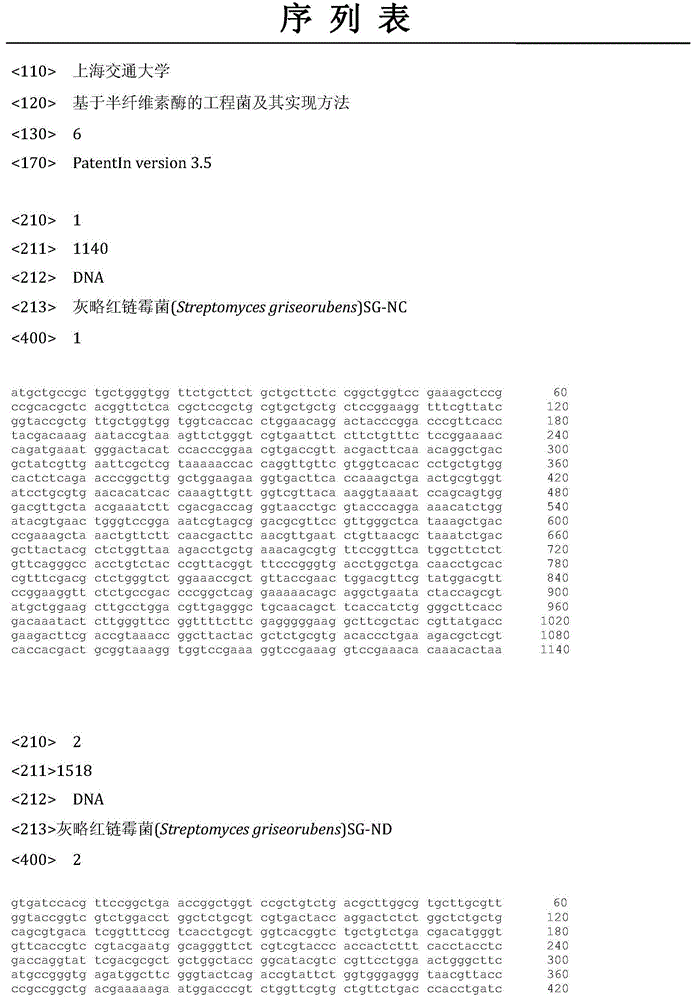Hemicellulase-based engineering bacteria and realization method thereof
A technology of hemicellulase and engineering bacteria, applied in the field of engineering bacteria based on xylanase and xylosidase, can solve the problem of inability to simultaneously ferment β-xylanase and β-xylosidase, and hydrolyze hemicellulose Insufficient thoroughness and other problems to achieve the effect of improving protein activity and solubility and ensuring quality
- Summary
- Abstract
- Description
- Claims
- Application Information
AI Technical Summary
Problems solved by technology
Method used
Image
Examples
Embodiment 1
[0028] In this example, Streptomyces griseorubens was isolated from rotten straw collected in Pujiang Town, Shanghai, and its preservation number is CGMCC No.5706. The strain was inoculated in LB liquid medium and cultured at 32°C for 48h.
[0029] The above LB liquid medium components are: peptone 10.0g / L, yeast extract 5.0g / L, NaCl 10.0g / L, pH 6.8-7.2. Add 15.0‐20.0g / L agar to the liquid medium to obtain LB solid medium.
[0030] 1) Genomic DNA extraction of Streptomyces griseorubens: collect 2.0 mL of bacterial liquid, and centrifuge at 12000 rpm for 2 min. Discard the supernatant, collect the bacterial pellet, add 180μL lysozyme (20mg / mL) and 20μL EDTA solution (0.5M, pH8.0), treat at 37℃ for 45min, add 4μL RNase A (100mg / mL), shake and mix for 15s , placed at room temperature for 5 minutes, and then completed the remaining operations according to the instructions of the bacterial DNA extraction kit (TIANGEN) to obtain high-purity genomic DNA. The quality of genomic DNA...
Embodiment 2
[0035] Construction of co-expression vector
[0036] 1) According to the optimized nucleotide sequence of xylanase and xylosidase, the sequences of PCR primers containing enzyme cleavage sites are designed as follows:
[0037] XL-Nco I-F: TACCATGGTGCTGCCGCTGCTGGGTGGTTCTGCTT
[0038] XL‐BamH I‐R:CGGGATCCTTAATGATGATGATGATGGTGTTTGTGTTTCGGACCTTTC
[0039] XO‐Nde I‐F:TACATATGGTGATCCACGTTCCGGCTGAACCGGCTGGT
[0040] XO‐Xho I‐R: CCCTCGAGTTAATGATGATGATGATGATGAGCGGTGTCACGACCCA
[0041] 2) Use pUC57-XL as a template, and use primers containing Nco I and BamH I restriction sites for PCR amplification to obtain the xylanase gene sequence, and use DNA A-Tailing Kit to add A and then connect to T-Vector PMDs TM 19‐T (TaKaRa), and the ligation product was transferred into DH5α E. coli. Positive clones were selected, and plasmids were extracted by shaking bacteria for sequencing. If there is no mistake, Nco I and BamH I were subjected to double enzyme digestion (37°C) to recover the xyl...
PUM
 Login to View More
Login to View More Abstract
Description
Claims
Application Information
 Login to View More
Login to View More - R&D
- Intellectual Property
- Life Sciences
- Materials
- Tech Scout
- Unparalleled Data Quality
- Higher Quality Content
- 60% Fewer Hallucinations
Browse by: Latest US Patents, China's latest patents, Technical Efficacy Thesaurus, Application Domain, Technology Topic, Popular Technical Reports.
© 2025 PatSnap. All rights reserved.Legal|Privacy policy|Modern Slavery Act Transparency Statement|Sitemap|About US| Contact US: help@patsnap.com



